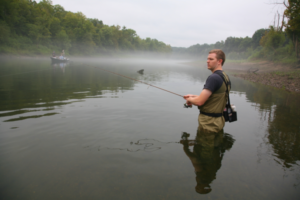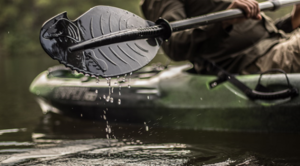Summer Bream at High Falls Lake
It has often been said that if bream got much bigger, our tackle would not hold them. Few other fish offer as much as bream – a good fight, excellent eating and memories for most of us of our first fish. High Falls Lake offers good bream fishing where you can enjoy all of their great qualities.
High Falls is a 660 acre lake located just off I-75 between Macon and Atlanta. The main lake is on the Towaliga River and there are three main arms, Buck Creek, Watkins Bottom and Brushy Creek running off it. The lake is lined with private cabins and there are two good boat ramps, one at the dam and one on Buck Creek.
It is a state park with special regulations. Boats are limited to 10 horsepower or less and all boats must be off the lake at night. Don’t get into a guessing game about the legal definition of dark – check out sunrise and sunset times and plan on launching at sunrise and coming in at sunset.
State regulations apply in other cases, so you need a Georgia fishing license and you can keep up to 50 bream each day. That includes all species and you may catch bluegill, shellcracker, warmouth and redbreast at High Falls. You will have to pay a $2 daily fee to launch your boat and park, except on Wednesdays which are free. An annual permit is available.
High falls is a fertile lake and has good populations of all game fish. The waters are not polluted, though, and there are no restrictions on eating fish from the lake. The lake is fairly shallow and is very silted in, with old channels mostly depressions and backs of creeks filled in with sand and mud.
Keith Weaver is the state fisheries biologists in charge of High Falls. He says the lake is an overlooked resource for all species of fish, and that there is a good population of bluegill in the lake. Their sampling shows you should catch a lot of bluegill in the half-pound range, fish 7 to 9 inches are there in good numbers. Shellcracker are not as numerous, but there are some big ones in the lake.
This has been a strange year for bedding fish of all species, and it may have made the bream bed at odd times at High Falls, according to Keith. Although the full moon is a prime time for bream bedding, the unstable weather we have had this spring has thrown them off. Bluegill will bed every month from April thorough September at High Falls, but the shellcracker will do almost all their bedding in April.
There is a full moon the July 16, 2019, so that week should be excellent for bluegill at High Falls. Keith says bigger bream usually are found toward the dam, so look for bedding fish in the small pockets and behind docks in that area.
After bedding is done, Keith suggests moving out to deeper water. Find stumps in 5 to 6 feet of water, especially along the old creek and river channels, and fish for bream there. Early mornings and late afternoons are the best times for bigger fish, and Keith said, without hesitation, that crickets as your best bait.
Shady areas also hold bream. Look for banks where tall trees keep the sun off the water longer, and find areas where the trees and bushes hang out over the water and provide shade. Boat docks also provide shade, and most have brush around them, making bream fishing even better. Be careful when fishing around docks to not disturb the dock owners poles left out to catch fish.
For shellcracker Keith suggest Watkins Bottom. The fish will hold on the stumps along the old creek channel there and hit crickets in 5 or 6 feet of water. The channel is deep enough to offer a thermal refuge of cooler water when the sun gets hot in June. If you catch one you can anchor and fish the area carefully, there should be others nearby.
Jim Berry owns Berry’s Sporting Goods in Griffin and has fished High Falls all his life. An mount of an 11 pound bass at the store shows the kind of bass he has caught there. Jim also likes to fish for bream at High Falls, and had a cabin on the lake for years. Add that to the fact he talks to fishermen every day that are buying bait and tackle will give you an idea of his knowledge of the bream fishing on the lake.
Jim and I went to High Falls during the full moon in May expecting to find lots of bream beds. We put my bass boat in at the ramp in Buck Creek and fished from there to the mouth of Buck Creek, then across to Brushy Creek and all the way around it. We landed a lot of bream but most were small, and we found just a few beds.
Apparently the cool mornings we had put the bream off their bedding schedule. That may mean even more are bedding this month, making fishing even better there. The baits and tactics Jim suggests should help you find bream and catch as many as you want.
Jim likes all kinds of bream fishing and carried a fly rod, a cane pole and several light spinning and spin cast rods with us. He suggest using 6 to 8 pound line so you can pull your hook loose rather than breaking it off when you get hung. This also keeps you from going into and area where you are catching fish to get unhung, which would spook them.
There are three basic ways to find bream beds at High Falls. You can ride the shallows looking for the saucer shaped light colored depressions in the bottom, you can smell them when you get close, and you can often see the fish making the water ripple around beds.
A small jig or Beetle Spin type bait is a good search bait for bream. You can run the banks casting those baits while watching for bream beds and water movement. If you see the beds, or smell them, stop and make several casts. When you catch a bream, especially a good sized one, it is time to anchor and switch to live bait.
To find beds you can’t see, or to find schools of bream holding out from the bank, Jim likes to cast his Beetle Spin or jig to the bank and work it back with a rise and fall action. He says the bream usually hit the jig as it falls. His favorite colors are white or black jigs and when using just the jig he likes the Renosky jig in 1/16 to 1/32 ounce.
Fishing a fly is another good way to find bream. Jim likes a popping bug best but will use a rubber cricket or even a wet fly if that is what the fish seem to want. If you don’t have a fly rod, you can cast a fly using a clear bubble made for that purpose. It attaches to your spinning rod line and then you tie on a leader and your fly.
Sometimes it seems a bream will hit a fly or popping bug better than just about anything else. You can fish them slowly or fast, letting them sit until it drives the bream crazy. A sinking fly will also drift to the bottom so slowly that it looks irresistible. Give them a try.
We had crickets, red wigglers and meal worms from Jim’s store with us. All can be fished on cane poles or spinning outfits. Tie on a #6 or #8 hook, attach a small split shot about six inches above it and clip a cork to your line. Adjust the cork to the depth of the water, you want your bait to be near the bottom and the split shot should be at the depth below the cork to just touch the bottom.
If you can see the beds, cast to them and let the bait settle. If you don’t get hit immediately, slowly move it back toward you across the beds. It should not go far before a bream sucks it in. Jim says it is best to stay way out from the beds and make as long a cast as you can make effectively. This keeps from spooking the bream and making them move off the beds.
Jim likes a #8 hook for bream for a couple of reasons. One, it will straighten out easier if you get hung. And even more important, bream with their small mouths seem to take the smaller hook in better.
Good areas where Jim has found beds in the past include the last big cove on your right as you leave Buck Creek and enter the river. It is shallow and sandy, and bream bed all around it and even out in the middle toward the back. You can find bream beds all around Brushy Creek and the big flat in the back often has beds all over it.
In the river from the dam to the upper end, look for small pockets where the beds have some protection from the wind. Any backout can hold a few beds, and the bigger ones hold more beds. If your trolling motor is kicking up soft mud it is better to try to find a sandy area. You can check the bottom composition with a paddle, too.
The same baits work if you don’t locate a bed. You can anchor near the old river or creek channel and fish the live bait just off the bottom. There will be more and bigger bream present if there are stumps in the area. Let the bait sit longer to give them a chance to find it.
Jim likes the deeper banks in Brushy Creek as well as the channel in Buck Creek above the bridge. If you have a good depthfinder you can locate the deeper water with stumps, or you can cast a small jig until you start to get hung on them. Once you find them anchor and you can put out several rods or poles with different baits on them. If you start catching bream on one bait, switch the others to it if they are not hitting them as well.
There are a lot of old trees that have fallen from the bank and you can catch bream around them, too. Position your boat out from the tip and fish all around the trunk and limbs of the tree. A cane pole is a very effective way to do this because you can drop your bait into a hole in the limbs then pull it straight back up and out if you don’t get a bite.
Up the river above the confluence of Buck and Brushy Creek you can find a lot of overhanging willows. Stay on the deeper side and fish under them. This should give you action all day long, and you can also get out of the sun here, an important consideration as June wears on and it gets hotter.
As Jim and I loaded my boat, Tommy Lance came up and started talking to us. He was surprised we put my bass boat in the lake, but we explained it was OK as long as you don’t crank the gas engine. If you crank a big motor at High Falls you can bet someone will call and the game warden will be waiting on you with his ticket book! Your trolling motor should move you around fine on the lake.
Tommy saw some of the bream we caught and said he had fished for bream there many years. He had a cabin on the lake for a while and spent many hours catching bream on the lake. He offered a few suggestions for finding bigger bream, especially if they are bedding.
In Buck Creek if you go upstream from the landing the creek makes a bend, and the right bank is deeper. There is good bream fishing all along that bank, according to Tommy. You can fish live bait or artificials around the docks and trees in the water, and bream do bed in the shallow areas.
Tommy’s favorite area to fish for bedding bream is up the Towaliga River. There is an area where a big pond is off to the side and it is called the Duck Pond. He says head up that way and when you see the grass growing out in the middle of the river in a shallow area, fish the left side out from the boat docks and cabins there. That is a big flat and the bigger bream in the area like to bed and hold there.
Also, there is a slough on the left going upstream before getting to the Duck Pond. That is another good area to fish for bream, around the mouth of that slough and into it. There is an old boat dock there you can fish around, also.
Also, there is a slough on the left going upstream before getting to the Duck Pond. That is another good area to fish for bream, around the mouth of that slough and into it. There is an old boat dock there you can fish around, also.
Tommy’s favorite bait is a cricket fished under a cork. It can be fished around all kinds of cover and across beds, too. Crickets will catch anything in High Falls, including the bigger bluegill.
One of the best things about fishing at High Falls is the peace and quiet. Every time I go there I am reminded how nice it is to fish and not be bothered by skiers, jet skis and big cruisers. You will hear the occasional fishing boat or see folks on a pontoon out riding around, but the 10 horsepower limit means lowered noise levels. It is very enjoyable.
Give High Falls a try for bream this month. You can check with Jim at his store in Griffin for the latest fishing information on the lake, and also get anything you need for fishing there. As Keith says, High Falls is an overlooked resource. Look at it and take advantage of some good, peaceful fishing.


